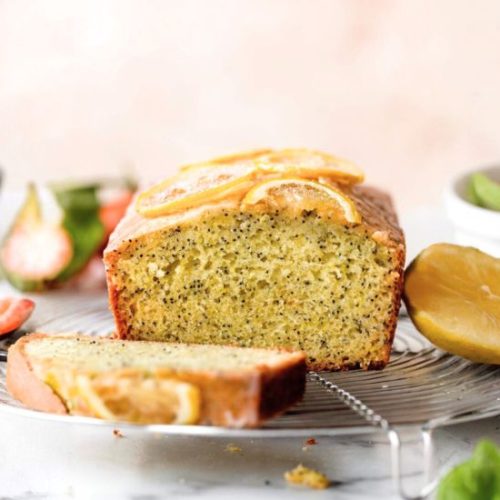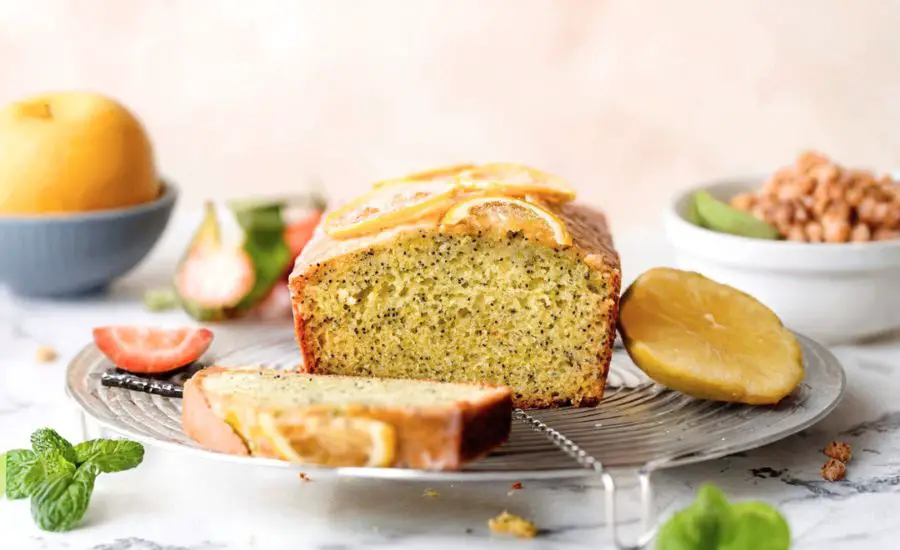All products are selected by our editorial team for quality. If you buy through our links, we may earn a small commission at no extra cost to you.
This Lemon Poppy Seed Bread stands out for its perfect balance of moistness and bright citrus flavor, achieved through the clever use of oil and sour cream.
The lemon zest and juice add a refreshing tang that makes each bite lively and satisfying.
Beyond taste, this quick bread offers moderate protein from the egg and good fats from the vegetable oil, while remaining relatively low in saturated fat thanks to the use of whole milk and sour cream rather than butter.
The poppy seeds contribute a subtle crunch and a tiny boost of fiber.
Its straightforward prep and bake time make it an ideal choice for everyday baking—whether as a quick breakfast, an afternoon snack, or a delightful treat with tea.
Additionally, the recipe’s flexibility to convert into muffins or mini loaves expands its usability for meal prep or sharing.
The optional light lemon glaze enhances moisture and sweetness without overpowering the bread, perfect for those who want a touch of indulgence.
Overall, this recipe is a delicious, approachable way to enjoy a citrus-flavored, moist bread that feels both comforting and fresh.
Must-Have Tools for Perfect Results
9×5-Inch Loaf Pan
Essential for shaping the bread into its classic form, this pan ensures even baking and a beautiful golden crust. Its sturdy construction also makes it versatile for other quick breads and cakes in your kitchen.
Glass Mixing Bowls
Perfect for mixing wet and dry ingredients separately, these bowls resist staining and retain temperature well, making them indispensable for consistent baking results.
Whisk
A reliable whisk is crucial for blending wet ingredients smoothly and incorporating air gently into the batter, helping to avoid overmixing and ensuring a tender crumb.
Cooling Rack
Elevates the bread off the countertop, allowing air to circulate and preventing sogginess by cooling the loaf evenly—an absolute must for preserving texture and freshness.

Lemon Poppy Seed Bread
Equipment
- 1 × 9×5 inch loaf pan
- 2 × Glass mixing bowls (medium and large)
- 1 × Whisk
- 1 × Cooling rackAsk ChatGPT
Ingredients
- 2 cups 250g all-purpose flour, gently spooned and leveled
- 4 teaspoons poppy seeds
- 1 teaspoon baking soda
- ½ teaspoon baking powder
- ¼ teaspoon salt
- 1 large egg at room temperature
- ¾ cup 150g granulated sugar
- ⅓ cup 80ml vegetable oil
- ⅓ cup 80g sour cream (or substitute plain/Greek yogurt), at room temperature
- ⅔ cup 160ml whole milk, at room temperature
- 3 tablespoons 45ml freshly squeezed lemon juice
- 1 tablespoon lemon zest from about one medium lemon
For the glaze:
- ½ cup 60g powdered sugar
- 1 tablespoon 15ml lemon juice
- Optional: candied lemon slices for decoration
Instructions
- Prepare the Oven and Pan: Set your oven to 350°F (177°C) and lightly grease a standard 9×5-inch loaf pan with nonstick spray or butter. This will ensure your bread releases easily after baking.
- Combine Dry Ingredients: In a large mixing bowl, whisk together the flour, poppy seeds, baking soda, baking powder, and salt until evenly mixed. This ensures your leavening agents and flavorings are well distributed.
- Mix Wet Ingredients: In a separate medium bowl, beat the egg and granulated sugar together until smooth and slightly thickened. Then add the vegetable oil, sour cream, whole milk, lemon juice, and lemon zest. Stir gently until the mixture is homogenous.
- Bring Batter Together: Pour the wet mixture into the dry ingredients bowl. Using a spatula or whisk, fold gently until just combined. Some small lumps are fine—overmixing can make the bread tough.
- Transfer to Pan and Bake: Spread the batter evenly in your prepared loaf pan. Bake for about 50 to 60 minutes, checking around the 50-minute mark. If the bread starts browning too fast, loosely cover with foil to prevent over-browning. Insert a toothpick into the center; when it comes out clean or with a few moist crumbs, the bread is done.
- Cool Completely: Place the loaf pan on a wire rack and allow the bread to cool fully in the pan. This resting period helps the bread set and makes slicing easier.
- Prepare and Apply Glaze: In a small bowl, whisk together the powdered sugar and lemon juice until smooth. While the bread is still warm, drizzle the glaze over the top so it seeps in, adding extra moisture and tang. Garnish with candied lemon slices if desired.
- Serve or Store: Once glazed and cooled, slice the bread to serve. Store leftovers at room temperature for up to 2 days, or refrigerate for up to one week in an airtight container.
Notes
- Freezing Tips: This bread freezes beautifully, glazed or plain. Wrap tightly in plastic wrap and foil, and freeze for up to 3 months. Thaw overnight in the fridge before serving or glazing.
- Dairy Choices: Full-fat sour cream and whole milk contribute to the bread’s moist texture and rich flavor. You may substitute plain yogurt but avoid low-fat or dairy-free versions to maintain the same texture.
- Texture Variations: If you want to make muffins or mini loaves, use the same batter and adjust baking times accordingly. Muffins bake faster and mini loaves vary depending on size.
- Flavor Swaps: Feel free to experiment by replacing lemon juice and zest with other citrus like orange or lime. Poppy seeds can be swapped with black sesame or chia seeds for a twist.
- Avoid Overmixing: Stir the batter until the ingredients just come together to keep the crumb tender and soft.
Chef’s Secrets for Perfect Lemon Bread
Achieving the perfect moist and flavorful lemon poppy seed bread starts with balancing ingredients and careful mixing.
Using oil combined with sour cream (or Greek yogurt) keeps the crumb tender and moist, avoiding the dryness that sometimes happens with butter-only recipes.
Be sure all wet ingredients are at room temperature to create a smooth batter that blends easily.
When mixing, resist the urge to over-stir; a few lumps in the batter are okay and help prevent a dense, tough texture.
For the best lemon flavor, freshly zest your lemons just before baking and use fresh lemon juice rather than bottled—this brightens the bread’s aroma and taste.
Baking with a foil tent halfway through prevents over-browning while allowing the loaf to cook through evenly.
Lastly, glazing while the bread is still warm lets the sweet-tart topping soak in, enhancing moisture and adding a subtle shine.
Serving Suggestions to Impress Guests
This lemon poppy seed bread shines as a versatile treat perfect for many occasions.
Serve it slightly warm for breakfast alongside a cup of tea or coffee to start your day with a refreshing citrus boost.
It also pairs wonderfully with cream cheese or a light spread of butter for a rich, creamy contrast.
For a delightful afternoon snack, slice the bread and top with fresh berries or a dollop of Greek yogurt.
If you’re hosting brunch, consider presenting mini loaves or muffins on a decorative platter alongside fresh fruit and citrus-infused beverages.
The bright lemon glaze adds a touch of elegance, making it suitable for casual gatherings or special celebrations alike.
Storage Tips to Keep Bread Fresh
Proper storage is key to maintaining the soft texture and vibrant flavor of lemon poppy seed bread.
Store the loaf covered at room temperature for up to two days, ideally wrapped in plastic wrap or kept in an airtight container to prevent drying out.
For longer preservation, refrigerate the bread for up to a week, but allow it to come back to room temperature before serving to regain its moistness.
You can also freeze the bread—both glazed or plain—in airtight packaging for up to three months.
When ready to enjoy, thaw overnight in the refrigerator and optionally add fresh glaze to revive that luscious finish.
Avoid storing in direct sunlight or near heat sources, as citrus flavors can fade and texture may suffer.
Frequently Asked Questions Answered Clearly
Q1: Can I substitute the sour cream?
Yes! Plain Greek yogurt is a great substitute for sour cream and will maintain the bread’s moistness. Avoid fat-free or non-dairy alternatives as they may change texture and flavor.
Q2: What if I don’t have poppy seeds?
You can skip them entirely or substitute with black sesame seeds or chia seeds for a similar crunch and visual appeal.
Q3: Can I use bottled lemon juice instead of fresh?
Fresh lemon juice is highly recommended for the brightest, freshest flavor, but bottled lemon juice can be used in a pinch—just be mindful it may be less vibrant.
Q4: How can I tell when the bread is done?
Insert a toothpick into the center of the loaf. If it comes out clean or with a few moist crumbs, the bread is ready. Baking times vary with oven type, so start checking around 50 minutes.
Q5: Can this recipe be made into muffins?
Absolutely! The batter works well for muffins or mini loaves. Adjust baking times accordingly—muffins usually bake in about 20-22 minutes at 350°F (after a brief high-temp start) and mini loaves depend on size.
This recipe is inspired by sallysbakingaddiction and has been carefully refined to enhance clarity, streamline preparation steps, and ensure accurate results. We’ve also included health benefits, nutritional highlights, and Must-Have Tools to help you get the best results every time you cook.


